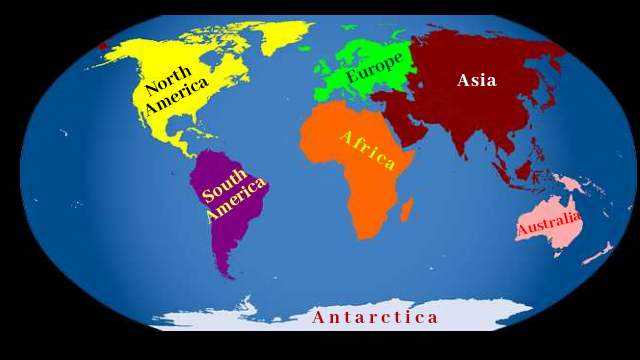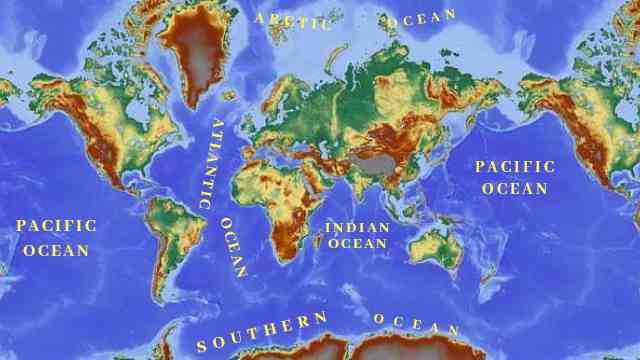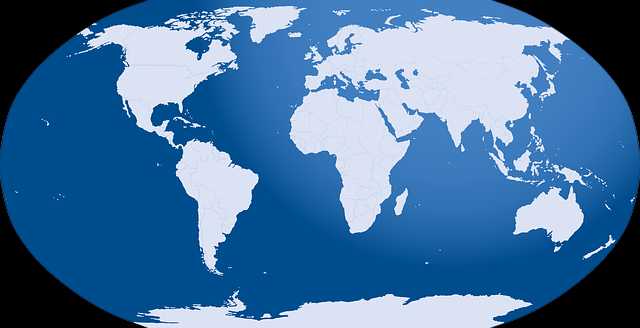 |
| the Continents and Oceans of the world |
If you are preparing for the examinations and you want to learn geography, you should have a basic knowledge about the Continent and Oceans.
This post is introducing you to the oceans and continents of the world, as well as some worksheets for continents and oceans are also provided below for self-practice.
There are so many theories provided related to the constructions of the Continents and Oceans but the Continental Drift Theory and the Sea Floor Spreading Theory are the best classifications of the formations of the continents and oceans.
On the basis of the evidence of fossils and climates the continental drift theory was published by 'Alfred Wegener' in 1912. According to this theory, the present continents were formed by the breaking up and shifting of a big plot.
'Wegener' said that the present continents were attached with a big plot and which was surrounded with waters on all sides. 'Wegener' named it the Pangea and the Panthalassa respectively. In the early stages, a sea was on the Pangea, Wegener called him Tethys sea. The Northern part of Tethys sea was Angarsland while the Southern part was called Gondwanaland.

In the last of the carboniferous era, the Pangea was started breaking and shifting due to Internal forces of the earth. The present continents, Islands, and oceans were formed by the process of the land shifting.
Continents of the Northern Hemisphere were formed by shifting of Angaraland, so North America, Europe, and Asia are the part of Angaraland. While South America, Africa, Australia, and Antarctica which are situated in the Southern Hemisphere are the parts of Gondwanaland.
Definitions of the continents and oceans of the world
Before knowing about the name and numbers of the world's continents and oceans, I would like to tell you, what are the continents and oceans?
The Continent:
The continents are a prominent feature of the earth, which have covered about one-third of the Earth surface.
"A broad part of the land which is surrounded from waters by all sides is known as the Continent".
In other words, the continents are a continuous landmass on the earth which includes all geomorphological features like Plains, Plateau, Mountain ranges, etc.
The Ocean:
About two-thirds of the earth's surface is covered by water bodies like Oceans, Seas, Lakes, and Rivers.
"Oceans are the vast water-bodies separated between the two or more continents".
Generally, you can say that Ocean is a deep and broad part of the earth surface which is filled with saltwater. Ridge, Basins, Trenches, Islands, Coral reef, etc are the main physical features of oceans.
The most important thing about the oceans are, they are continually
attached to each other. There are not any physical boundaries that are separated each-other. All oceans are divided orally on the basis of continental areas.
You may know here the Highest Mountain of the World
List of the Continents and Oceans from largest to smallest
There are 7 Continents and 5 Oceans in the world which covered respectively 29% (includes continents and Islands) and 71% ( Includes Oceans, Sea, Lakes) areas of the Earth Planet. The area of the land and water are different in both the Northern and Southern Hemisphere.
About 66% of lands are in the Northern hemisphere of the total area of landmass, while 80% of waters in the Southern hemisphere of the total Oceanic water.
Continents of the World
- Asia
- Africa
- North America
- South America
- Antarctica
- Europe
- Australia
 |
| 7 Continents of the world |
The Asia Continent
As a view of the area, Asia is the largest continent of the World. Area of this continent is about 44 million square kilometers which cover one-third of the land surface of the world.
Asia totally lies in the Northern Hemisphere. It is separated from North America by Bering strait while it is separated by the Suez Canal from the Africa Continent.
The Africa Continent
Africa is the second-largest continent in the world. Area of Africa is about 30 million square km, which is about 20 % of the total land area of the Earth. The greater part of Africa remained unexplored for a long time till the last 19th century, so that it has been also called the "Dark Continent".
The Gibraltar strait and the Mediterranean sea separates it from Europe, while it is separated from Asia by the Red Sea and the Suez canal.
Africa is only one continent where the Equator, Tropic of Cancer, and the Tropic of Capricorn lines are passing. Thus it is situated in both Hemisphere.
The North America Continent
North America is the 3rd largest continent of the world, It is spared 24 million square kilometers over the earth, which covered about 16% of the total land area of the earth.
The North and South America are formed by a single landmass, both are connected by the Panama isthmus but the Panama Canal separates it from each other.
There are many small and large bays and islands around this Continent, the world's largest island 'Greenland' is situated in the northeast side of this continent which is under Denmark. Hudson bay is also the largest bay of the world which is situated in the north of the continent.
The South America Continent
South America is the 4th largest continent, Area of South America is about 17.5 million square km. It is separated from North America by the Panama Canal which links the Atlantic and the Pacific Ocean.
South America is joined with the North American by the narrow landmass called the Isthmus of Panama. South America was first colonized by Latin race and It's also included in the group of Latin countries (Mexico, Central America, West Indies). So North America is also known as Latin America. The longest mountain range of the world 'Andes' is situated in the western part of South America.
The Antarctica Continent
The 5th largest continent Antarctica which lies around the South Pole of the Earth. Due to the cold climate, It is always covered by a thick sheet of ice, so it is also known as the 'White Continent'.
Antarctica is the only continent in the world where there are no permanent human settlements. This continent is used as a laboratory of the world. Penguin is a special bird which is only found in this continent.
The Europe Continent
The 6th largest continent of the world Europe wholly lies in the Northern Hemisphere.
Europe and Asia together belong to the same landmass. It is not separated by the large water mass. It is separated from Asia by Ural mountain and Ural river. Together Europe and Asia are called 'Eurasia'. But Europe is treated as a separate continent for all practical purposes.
The Australia Continent
The smallest continent of the world is Australia which wholly lies in the Southern Hemisphere. Australia is also the only country in the world which covers an entire continent. It is spared about 7.6 million km.
Australia was first discovered by 'Tasman' in 1641. He first discovered the Southern part of Australia.
Kangaroos are the special animal that is only found in Australia so it is known as the country of Kangaroos. Due to the less of rainfall, it is also called as the Country of 'Thirsty Land'.
You may also know about the Geography of India here.
Oceans of the World
Pacific Ocean
Atlantic Ocean
Indian Ocean
Arctic Ocean
Southern Ocean
Pacific Ocean
Atlantic Ocean
Indian Ocean
Arctic Ocean
Southern Ocean
 |
| The 5 Oceans of the world |
Pacific Ocean
It is the largest ocean of the world which acquired one-third area of the earth. Pacific ocean is spared between the west part of South America, North America, and east part of Asia and Australia in the O shape. The total area of this Ocean is about 16.5 crores square km, which is about 46% of the total area of oceans.
The Pacific Ocean is also divided into the North Pacific Ocean and South Pacific Ocean. Approximately 20 thousands small and large Islands are situated in this ocean, more in the south Pacific Ocean. The deepest Trench of the world 'Mariana Trench' (11022 m) is situated near the Philippines in the Pacific Ocean.
Atlantic Ocean
The Atlantic is the second-largest ocean of the world, which is spared in S shape between the North and South America, Europe and Africa continents. It is also known as the Andhra Ocean.
Area of the Atlantic Ocean is 820 lakhs square km, which is about 22% of the area of the total ocean and covered ⅙ area of the earth. The line of Equator is passed in the middle, so the ocean is divided into North and South. The Atlantic Ocean is the maximum widely in the Southern part.
Bermuda Triangle is a mysterious place that is situated in the Western part of the North Atlantic. One of the world's fastest ocean currents 'Gulfstream' also flows in the Western part of the North Atlantic Ocean.
The North Atlantic Ocean is the world's busiest trade route.
Indian Ocean
As a view of the area, the Indian Ocean is the third largest Ocean in the world. It is the only ocean in the world which is named after a country (India).
It lies to the south of Asia, west of Australia, and east of Africa. Area of the Indian Ocean is 730 lakhs square km, which is about 20% of the total ocean's area. Sunda is one of the deepest trench of the Indian Ocean which is situated in the west of Indonesia.
Arctic Ocean
The Arctic is the smallest ocean in all, which surrounds the North Pole and lies within the Arctic Circle. The Arctic Ocean is bounded by Alaska, Canada, Greenland, Scandinavia, and Russia. The area of the Arctic Ocean is 140 lakhs square kilometers which are about 4% of all oceans.
A narrow stretch of water known as Bering Straits connecting it with the Pacific Ocean. Due to the cold climate, It is also a very cold ocean.
Southern Ocean
The Southern Ocean is considered to be the 5th Ocean which lies around the Antarctica continent. 60° South Latitude is separated from all oceans.
The name of this Ocean is provided by the U. S Board of the geographic name. The boundaries of this ocean were proposed in the year 2000 to the IHO. But all member countries are not agreeing and not considering it to be a separate ocean also.
worksheet for continents and oceans
- Write the name of 7 continents on the map.
- Put the number 1 to 7 on the map for largest to smallest continents.
- Identify the oceans and write their name on the map.
- Find the Indian Ocean and the Arctic Ocean on the map.
- Find the given places with help of the Atlas on the map and write serial number 👇
a. Bering Straits
b. Panama Canal
c. Red Sea
d. Suez Canal
e. Ural Mountain
 |
| The Continents and Oceans |
The continents and oceans of the world are the basics of geography. It is very essential for students who want to learn geography and know about the world for other purposes. You should do the work on worksheets for memorizing all the continents, Oceans, Islands, and other physical features of the earth, as well as you should also use the Atlas (Map Book).
You may also know:
Important Environmental Questions and Answers

إرسال تعليق